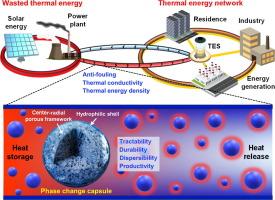Phase-Change Millicapsules with Highly Conductive and Adsorptive Radial Frameworks for Efficient Thermal Energy Management
IF 11.6
1区 工程技术
Q1 ENGINEERING, MULTIDISCIPLINARY
引用次数: 0
Abstract
In conventional thermal energy network (TEN) systems, heat loss and fouling in long pipelines reduce energy efficiency and hinder sustainable operation. Phase-change capsules (PCCs) are promising dispersoids for flexible energy storage and delivery; however, their thin shells compromise structural stability, limiting their fabrication to the micro- or nano-scale and restricting practical applications. Herein, we introduce hydrophilic milliscale PCCs (HMPCCs) as a pragmatic solution for efficient thermal energy delivery and antifouling in TENs. HMPCCs feature a thin shell and internal three-dimensional radially conductive and adsorptive frameworks with hierarchical pores (80% porosity), which provide enhanced thermal conductivity; a high adsorption capacity for Ca2+, Mg2+, and Fe3+ ions; and efficient phase-change material encapsulation without leakage. Incorporating clinoptilolite nanoparticles into the HMPCCs further increases the thermal conductivity, supplements the adsorption capability for Ca2+ and Mg2+ ions, and optimizes the bulk density for stable dispersion in water. HMPCCs achieved 100% removal efficiency for scaling cations (0.1–1.0 mg L–1) and exhibited excellent durability, maintaining structural integrity after 1000 phase-change cycles. A thermodynamic analysis confirmed that the adsorption process was endothermic, spontaneous, and thermodynamically favorable. Regeneration via low-energy desorption ensures its reusability and economic viability. These findings suggest that HMPCCs represent a scalable and sustainable solution for advanced TEN applications and have outstanding thermal management and antifouling capabilities.

具有高导电性和吸附性径向框架的相变微胶囊,用于有效的热能管理
在传统的热能网络(TEN)系统中,长管道中的热损失和结垢降低了能源效率,阻碍了可持续运行。相变胶囊(PCCs)是一种很有前途的柔性能量储存和输送分散体;然而,它们的薄壳损害了结构稳定性,限制了它们在微或纳米尺度上的制造,限制了实际应用。在此,我们介绍了亲水毫级PCCs (hmpcc)作为高效热能输送和防污的实用解决方案。hmpcc具有薄壳和内部三维径向导电和吸附框架,具有分层孔隙(80%孔隙率),提供增强的导热性;对Ca2+、Mg2+、Fe3+离子有较高的吸附能力;且相变材料封装高效,无泄漏。将斜沸石纳米颗粒加入到hmpcc中,进一步提高了导热性,补充了对Ca2+和Mg2+离子的吸附能力,并优化了堆积密度,使其在水中稳定分散。hmpcc对结垢阳离子(0.1-1.0 mg L-1)的去除效率达到100%,并且表现出优异的耐久性,在1000次相变循环后保持结构完整性。热力学分析证实了吸附过程是吸热的、自发的和热力学有利的。通过低能量解吸再生确保其可重复使用和经济可行性。这些发现表明,hmpcc代表了一种可扩展和可持续的解决方案,适用于先进的TEN应用,并具有出色的热管理和防污能力。
本文章由计算机程序翻译,如有差异,请以英文原文为准。
求助全文
约1分钟内获得全文
求助全文
来源期刊

Engineering
Environmental Science-Environmental Engineering
自引率
1.60%
发文量
335
审稿时长
35 days
期刊介绍:
Engineering, an international open-access journal initiated by the Chinese Academy of Engineering (CAE) in 2015, serves as a distinguished platform for disseminating cutting-edge advancements in engineering R&D, sharing major research outputs, and highlighting key achievements worldwide. The journal's objectives encompass reporting progress in engineering science, fostering discussions on hot topics, addressing areas of interest, challenges, and prospects in engineering development, while considering human and environmental well-being and ethics in engineering. It aims to inspire breakthroughs and innovations with profound economic and social significance, propelling them to advanced international standards and transforming them into a new productive force. Ultimately, this endeavor seeks to bring about positive changes globally, benefit humanity, and shape a new future.
 求助内容:
求助内容: 应助结果提醒方式:
应助结果提醒方式:


